What Glass Art Reveals About Karen Mooney’s Journey of Faith and Love
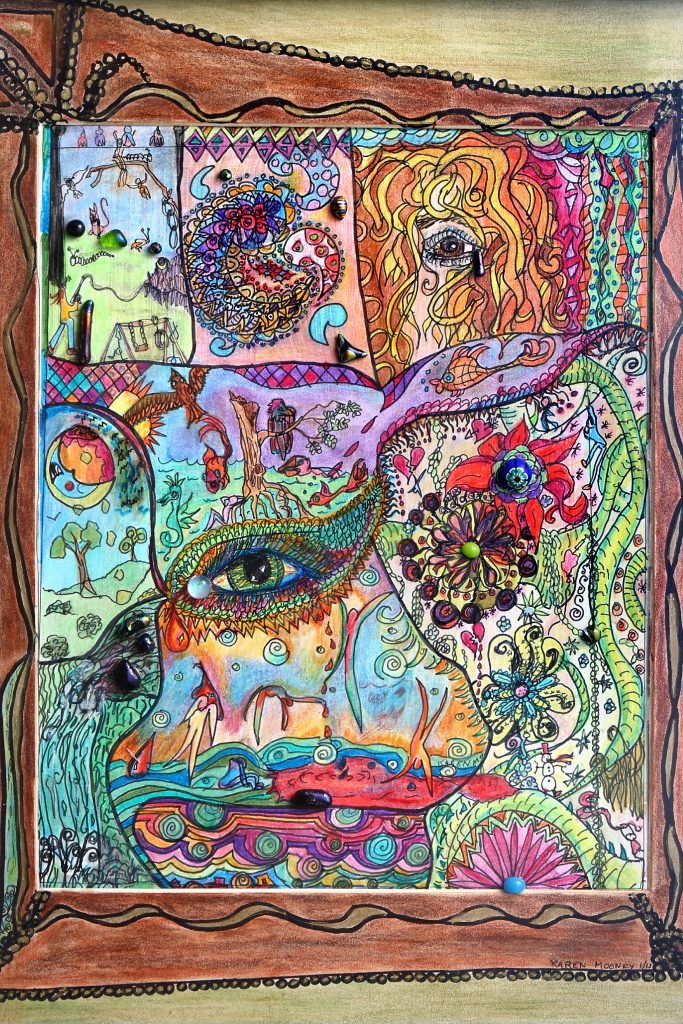
Karen Mooney is a talented mixed-media artist who weaves personal stories, faith, and a deep sense of spirituality into her artwork. In this interview, she opens up about her creative journey, her deep connection to faith, and how art became her way of healing after profound personal loss. She shares how mentors like Paul Stankard and artists like Joyce J. Scott and Wendy Bailye shaped her path and how working with materials like glass, wool, and beads allows her to tell powerful stories of love, unity, and resilience. Through this conversation, we learn about the spiritual roots of her work, the importance of community and diversity in her art, and how she finds purpose by creating pieces that uplift, comfort, and connect.
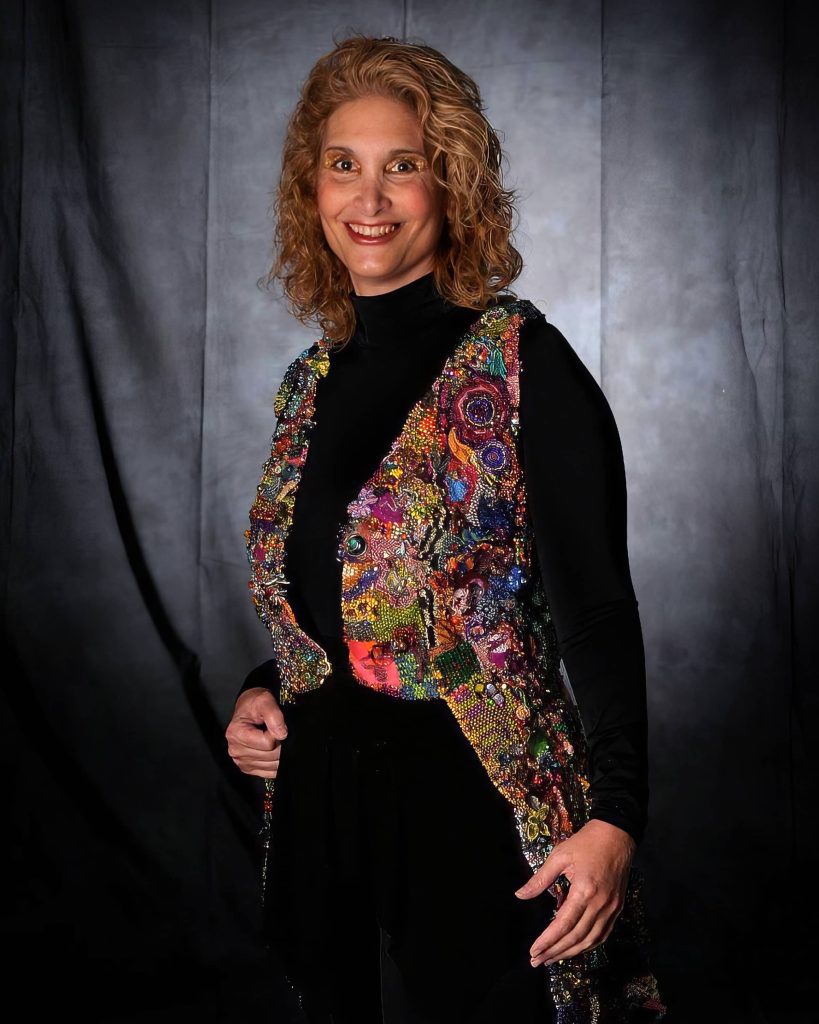
Mixed Media best explains my artwork. From 2008-12, I was a student at Salem Community College. I was fortunate to have Paul Stankard as my professor for 4 years. My degrees are in Fine Art Glass and Studio Arts. My piece, Joseph’s Cloak of Many Colors, was completed in 2012. Laura Donofer accepted the shawl into her Glass Fashion Show, where I walked the runway and wore it during the 2012 GAS Conference. Corning Museum of Fine Art Glass published a book displaying all the pieces. The Renwick Gallery of Smithsonian Art sponsored a show in 2013 where Fluehr Bressler, a prominent art collector, purchased my cloak.
She recently donated the Cloak to the Mint Museum in Charlotte, NC. I finished the Listening Shawl in January of 2024. Presently, I’m working on a costume for Laura Donofer’s 2026 Glass Fashion Show. In addition to my current body of work, I continue pursuing excellence in textiles through wet felting using sheep wool and many other textiles. My desire to bring community, brotherhood, and love to all people is expressed through the language and esthetics of glass art. I use colour, shape and texture to symbolize the beauty of all ethnicities and backgrounds. My purpose with my artwork is to promote change in the world, working towards unity and love between all peoples.
1. Who are some of your biggest influences or mentors in the art world?
I have been incredibly fortunate to have Paul Stankard as my mentor. I first met him while studying Fine Art Glass at Salem County Community College, which is also his alma mater. I had encountered his beautiful paperweights displayed at the Philadelphia Airport years earlier. I still remember lifting my young son to see a paperweight filled with lifelike bees, prompting him to ask, “Mommy, how did he get those bees in there?”—a question I’ve since heard echoed many times. Paul has also served as a spiritual mentor to me. During my first lecture with him, he shared that he always begins his torch work with a prayer, a practice that resonated deeply with me. Another artist I greatly admire is Joyce J. Scott.
I first discovered her work in the early 2000s and was awed by her massive beaded installations. Seeing them in person at the Corning Museum of Glass was mind-blowing—far more impactful than any photograph could capture. Later, I attended an International Flameworking Conference where she spoke, which expanded my understanding of the possibilities in beadwork. Her influence gave me the confidence to create “Joseph’s Cloak of Many Colors” in 2010. More recently, I’ve been inspired by Wendy Bailye, a textile artist specializing in wet felting. In 2024, I took her six-week course, which offers lifetime access to her techniques. Wendy generously shares everything she has learned; her insights into design and process are invaluable. While many teachers have shaped my artistic journey, Paul Stankard, Joyce J. Scott, and Wendy Bailye are the most influential figures in my work.
I credit God for my artistic talent and always ask Him to lead me in my artwork. Since I began doing this four years ago, I have not lacked inspiration.
Karen Mooney
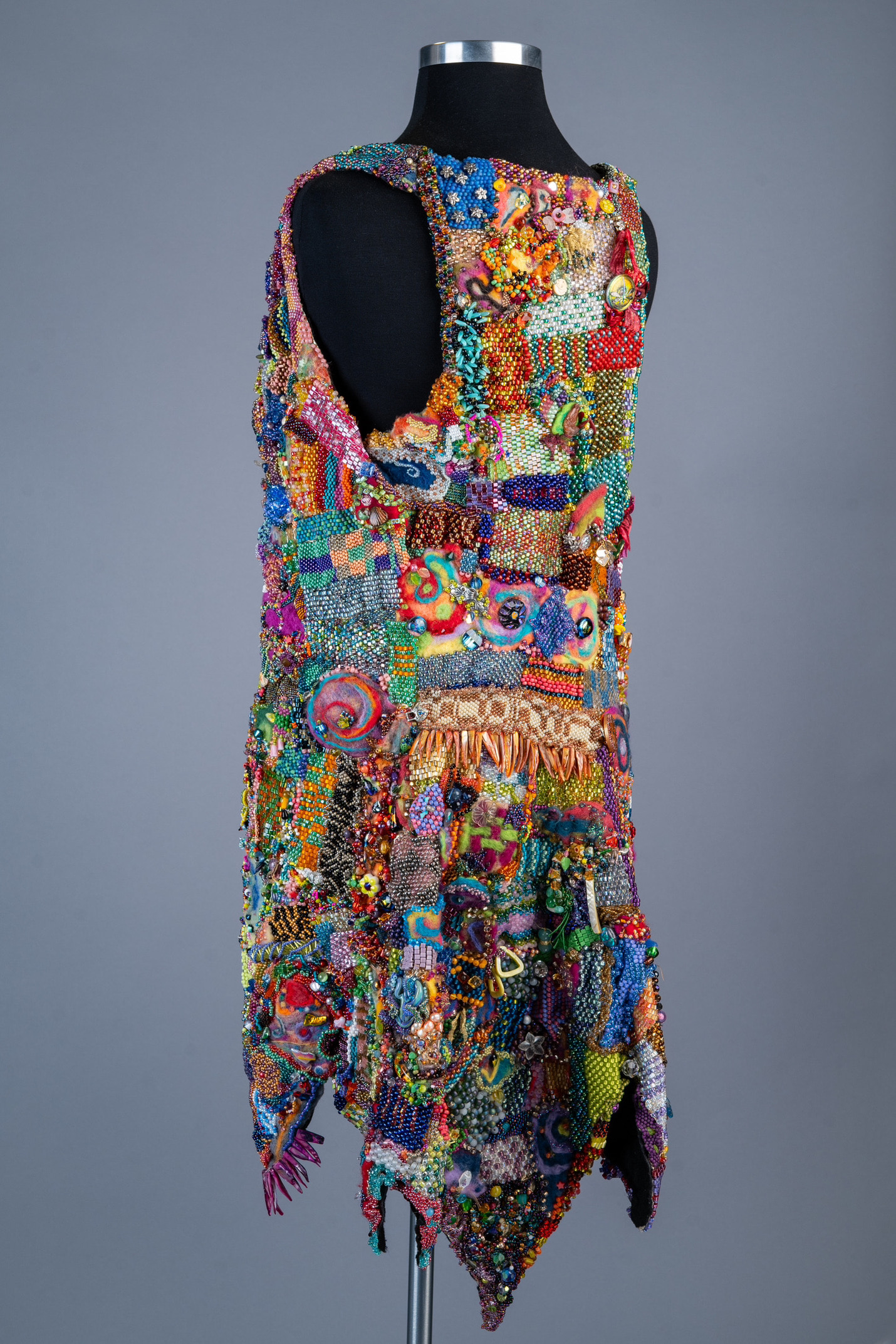
2. What mediums and techniques do you primarily work with?
I am a massive fan of all colours and love textures. The interplay of light and shadow and the changes it makes in artwork are something I find fascinating. I consider myself fortunate to be a visual artist working in mixed media. This affords me the pleasure of using many different mediums in my artwork. Jumping from sewing needles to beads, brushes, watercolours, and other artistic tools is rewarding and keeps my work fresh. In a single day, I can work in glass, textiles, paints, or any medium I choose. A significant amount of my work is done with glass. I get the added elements of light, shadow, and movement with glass. It is as if I’m watching a beautiful story unfold.
Another favourite medium of mine is wet felting. The beautifully coloured sheep’s wool and other textiles fuel my imagination. The tactile pleasure of touching wool, silk, and highly textured elements stimulates more of my senses. I also enjoy working with colour, watercolour, Derwent Inktense pencils and artist crayons. The vivid, bold, and saturated colours of Inktense products are unique and bring my artwork to life. I use a mixture of sculptural, tubular, and freeform peyote stitches in my beadwork. I rarely stick to one stitch, and I’ve recently developed a habit of using all of the stitches in unison. This style shows itself in my piece, The Vine and The Rock. I love to experiment and play with all mediums.
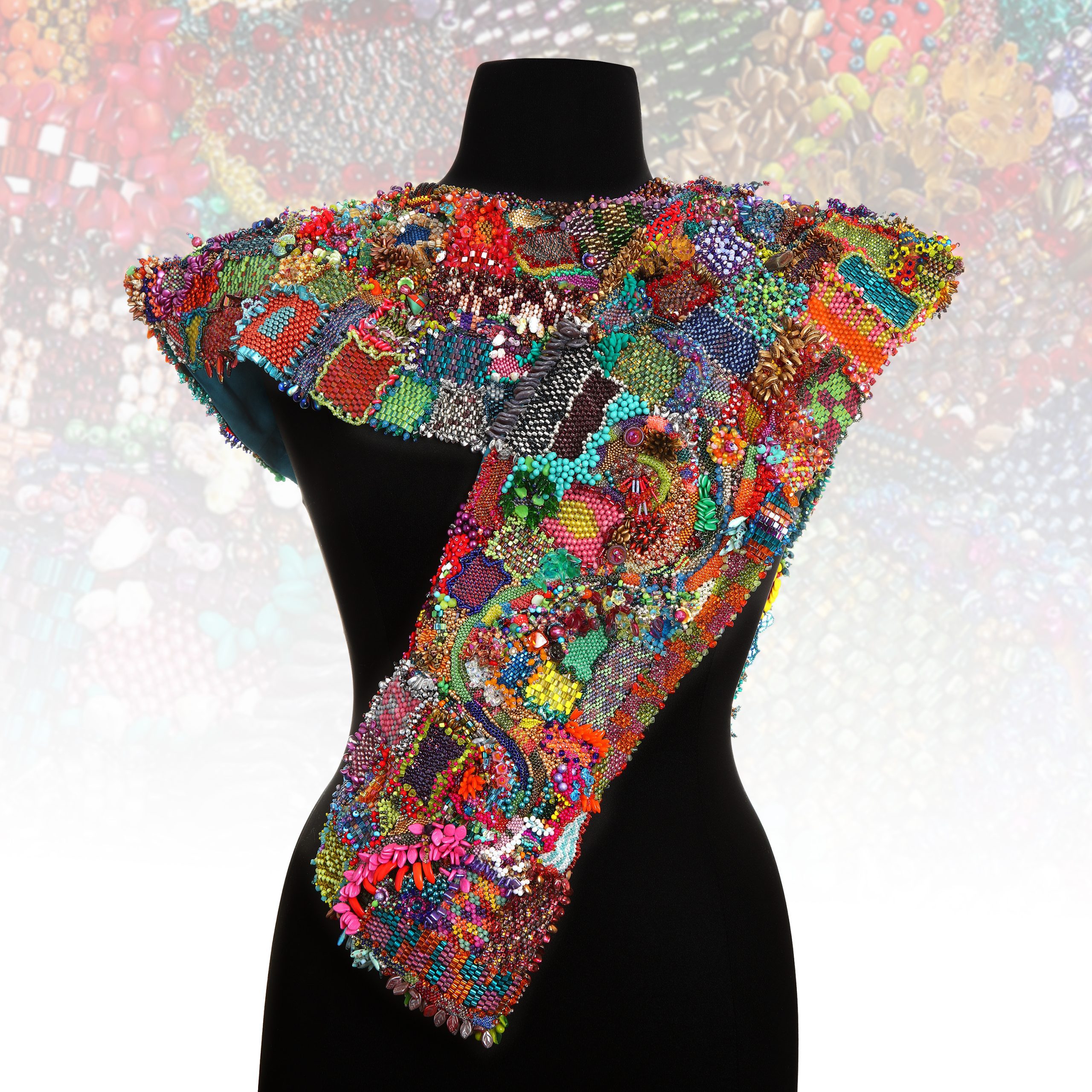
3. Where do you find inspiration for your artwork?
Over the years, I’ve been inspired by many people from all walks of life. I believe that all people have something to teach others. The first artist I found inspiration in was Vincent Van Gogh, an artist many love and enjoy. Art History was my favourite class in college and was very inspirational. Most importantly, the number one place I turn to for inspiration and ideas is Jesus. My relationship with him is very important to me. Much of my work is based on the Bible and biblical principles. My first significant work, “Joseph’s Cloak of Many Colors,” is based on the Bible story.
The Listening Shawl was born from a desire to hear God speaking to me. It took me the entire year I worked on it to understand I already heard that “still small voice.” I recently created The Vine and the Rock based on names believers call Jesus. I’m making a costume for Laura Donofer’s Glass Fashion Show, set to take place in 2026. The costume’s name is The Armor of God”. It will consist of multiple pieces. In my other work, the clay print entitled “The Upside Down Kingdom refers to the kingdom of God. More and more, my artwork seems to be taking on a spiritual bent. I credit God for my artistic talent and ask Him to lead me in my artwork. I have not lacked inspiration since I began doing this four years ago.
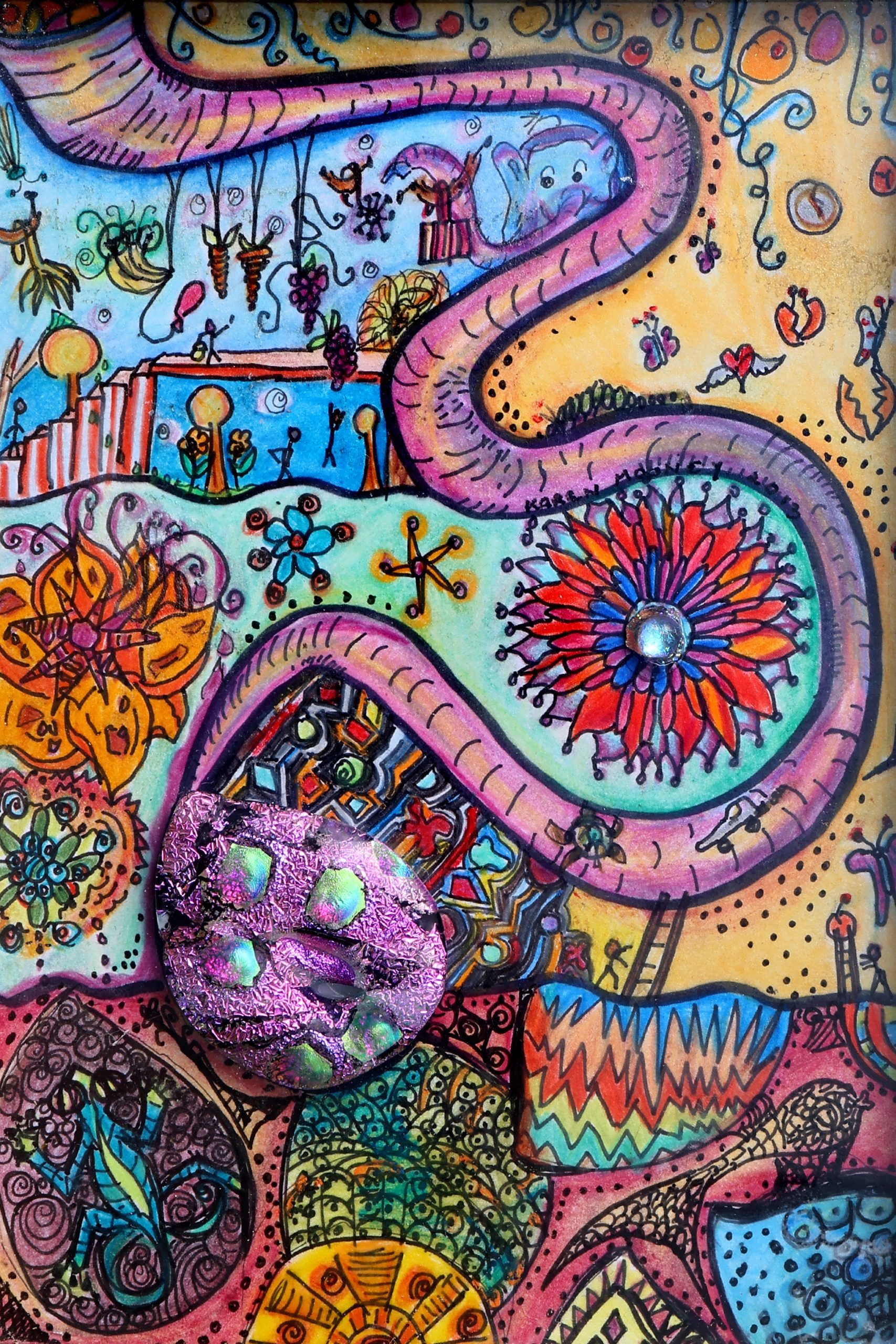
4. What challenges have you faced as an artist, and how did you overcome them?
After my son Donnie died, art became the only language I had for expressing my grief. My work fluctuated between extremes—bold colours and textures inspired me, but emotionally, I found myself in a dark and painful place. I was already living with depression, anxiety, fibromyalgia, narcolepsy, and chronic pain from a failed back surgery. Donnie’s death triggered a debilitating flare-up of all these issues. I lost my job, became disabled, and was barely surviving from day to day. In college, my early work reflected that suffering. My peers often called it morbid, full of disfigured self-portraits and unsettling themes. Even my whimsical Doodle Series carried symbols of death and pain.
The only exception was Joseph’s Cloak of Many Colors, which—unintentionally—hinted at something more profound: a longing for hope and unity. Everything shifted in 2015 when I turned my life back to the Lord. I remembered something Paul Stankard once said about viewing his work as a “physical prayer.” From that moment on, I approached my own art in this way: when I stopped chasing inspiration, it began to find me. I wouldn’t say I returned to joy or peace; instead, I discovered something entirely new. I felt like a new creation. Spirituality now saturates everything I make. I no longer create from a place of desperation but from a place of reverence. My art still honours my past and the grief I’ve carried, but it doesn’t dwell there—it points to healing, beauty, and God’s redemptive love. I am profoundly grateful for the gift of art. It gave me a voice when I couldn’t speak, a release when I couldn’t bear the weight of loss and a sacred way to stay connected to God through it.
I want to create pieces that live in people’s hearts, not just on their walls. If my art can make someone feel seen, inspired, or closer to God’s love, then I’ve fulfilled my purpose.
Karen Mooney
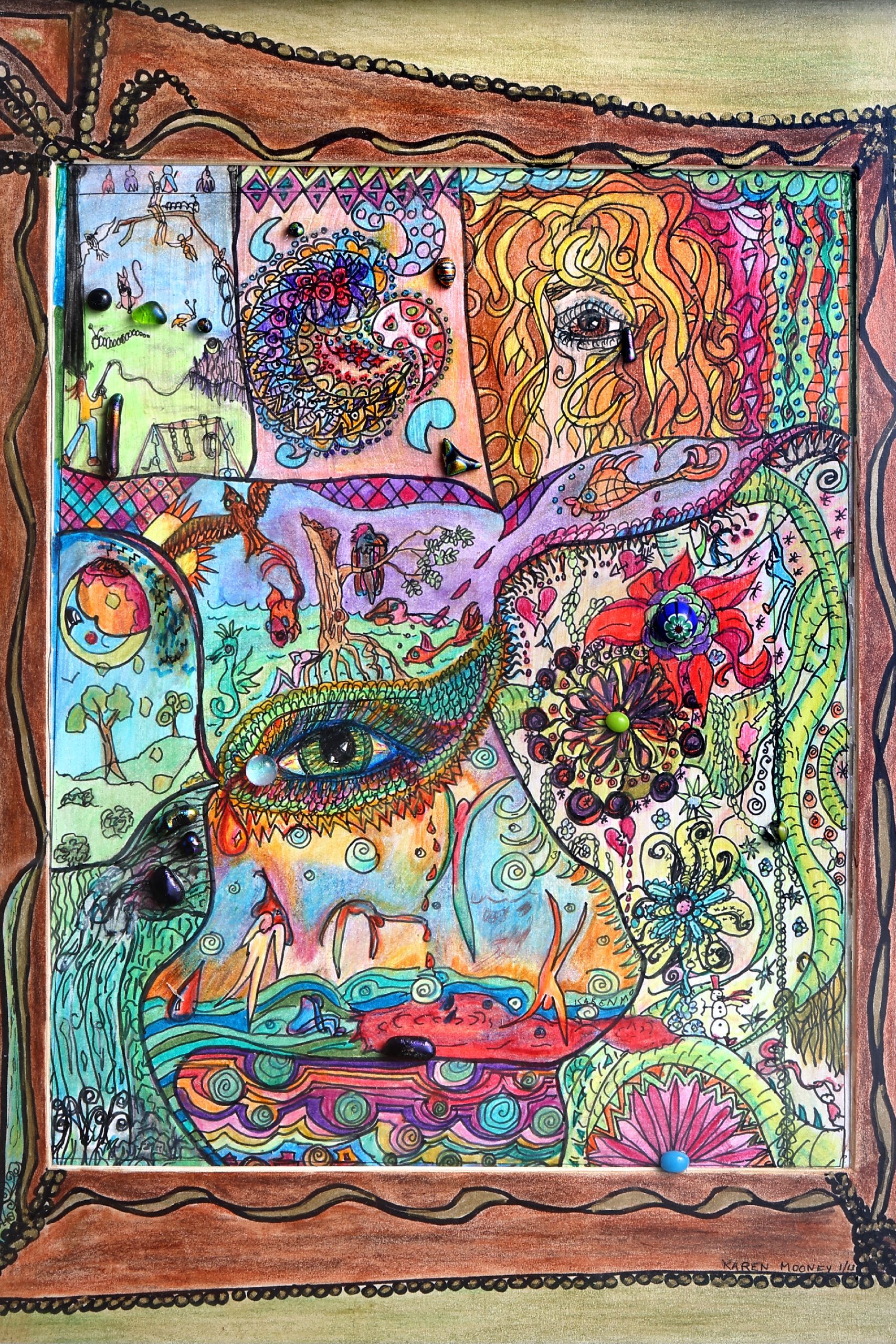
5. How do you see your legacy as an artist, and what do you hope to be remembered for?
I see my legacy as an artist rooted in love, faith, and the power of connection. Through every piece I create—whether it’s bold mixed-media, beaded textiles, or glass-infused prints—I aim to reflect the beauty and complexity of the human experience. My faith is the foundation of my work; it inspires me to create pieces that speak to the spirit, offer encouragement, and remind people they are deeply loved and not alone. I want to be remembered for creating art that bridges divides, celebrates diversity, and invites healing.
One of my most meaningful pieces, Joseph’s Cloak of Many Colors, symbolizes my desire for love and acceptance for all people. My collection My Life in Glass tells my story through colour and texture, allowing others to see themselves in work. Ultimately, I hope my art leaves behind a trail of beauty and belonging—a kind of visual testimony. If someone can look at my job, I’ve fulfilled my purpose and feel seen, inspired, or drawn closer to God’s love. I don’t just want to make art that hangs on walls—I want to create pieces that live in people’s hearts.

Karen Mooney’s art is deeply connected to her personal journey and faith. Through her work with glass, textiles, and beads, she shares stories of love, healing, and connection. Each piece speaks to her experiences with loss, growth, and the hope that we can all come together. Her art isn’t just something to look at—it invites us to feel, understand, and find comfort in knowing that we’re not alone. Karen’s work leaves a lasting mark, reminding us of the power of art to bring people together and make the world a little brighter. To learn more about Karen, visit the links below.
